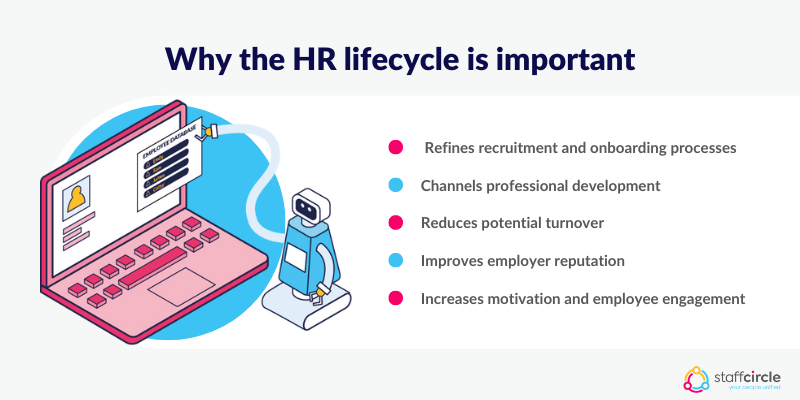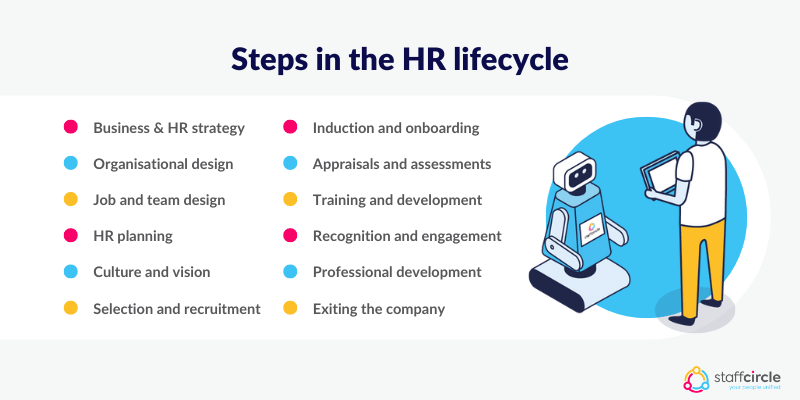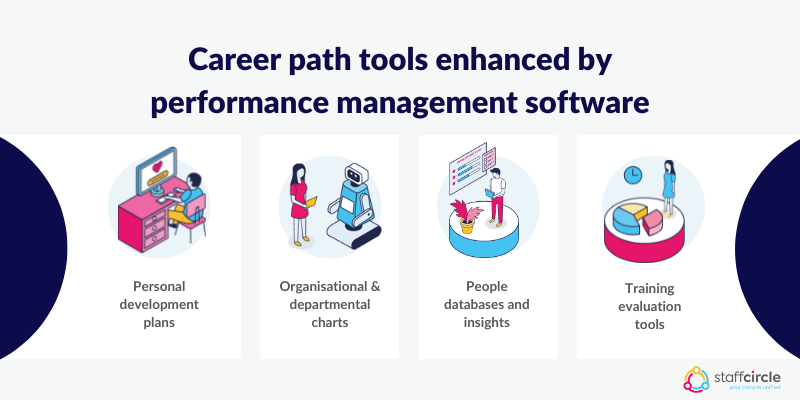What is the HR Life Cycle?
The HR life cycle represents the continuous process of a range of integrated activities carried out by a human resources team. This is intimately linked to an employee life cycle model, the overall business strategy, and how recruitment and training impact an organisation.
In human resource management, the way HR professionals approach their functioning is undergoing a transition. According to the report from the Harvard Business Review discussing the key business trends in 2022, new technology will play an increasing role in how tasks and processes are carried out.
“HR tech vendors have been creating products that replace an increasing number of repeatable managerial tasks, such as scheduling, approving expense reports, and monitoring direct reports’ completion of tasks. The next generation of technology will start to replace additional managerial tasks, such as providing performance feedback and supporting employees in building new peer-to-peer connections.”
In this guide, we’ll explore the importance of adhering to the HR life cycle, its key stages, and the steps HR leaders can take to ensure it is implemented for optimal success.

What is the Importance of an HR Life Cycle?
By applying the life cycle model, HR leaders and managers can evaluate and improve the opportunities for employees at every stage of their involvement with the company. An effectively applied HR life cycle:
- Helps to refine the recruitment and onboarding processes to ensure new hires are given a role with responsibilities that best suit their talents.
- Channels the professional development of new employees in the right direction, making sure they have the necessary training and resources to develop their talent stack
- Increases motivation and employee engagement by allowing them to focus on what matters the most to achieve their goals
- Reduces potential turnover through a better overall experience, making employees happier with their role in the company
- Improves the reputation of the employer by demonstrating a commitment to their employees across a range of measures

These outcomes should be embodied in the company culture and modeled by the HR department’s approach to the employee life cycle, as well as the leaders who run teams and departments, The role played by HR leaders in crafting this culture is outlined in the report from Gallup, Why HR Leaders Are Vital For Culture Change:
“By continually identifying the successes that come from the desired culture and how that culture empowers organizational objectives and outcomes, HR leaders can build momentum, increase accountability and demonstrate the bottom-line value of cultural change.”
Now, we’ll examine the five principal stages of the HR life cycle, and the steps that are taken as HR professionals work through this process.
Additional Read: Streamline All HR Operations
What Are the 5 HR Life Cycle Stages?
An effective HR life cycle helps to make sure the right people are in the right positions. It ties into the overall HR strategy, requiring consistent application at all times.
For a thorough understanding, let’s address the five HR life cycle stages:
1. Attracting and recruiting the best candidates
The HR life cycle begins with attracting and recruiting the best candidates to accomplish the company’s objectives. The attraction phase comes before any hiring takes place, and involves crafting the organisation’s brand through marketing and word-of-mouth.
This image then feeds into recruitment, with the establishment of a solid pipeline for candidates to make sure they are placed in the most appropriate positions.
2. Managing new hires through induction, orientation, and onboarding processes
Once a candidate has gone through a successful application process, HR must clarify expectations for the role and introduce them to the company. HR professionals can create more efficient processes for induction, orientation, and onboarding through the use of performance management software and its associated tools.
Onboarding processes can be set up with role-specific templates, while automated tools allow for employees to meet the team and get acquainted with procedures through schedules.
3. Personal and professional development
A key aspect of the induction process should include the creation of a Personal Development Plan (PDP). This helps to align a new employee’s career growth with the aims of the organisation as well as guide how their overall performance will be managed.
A Personal Development Plan also provides a useful point of reference for when managers and team leaders conduct monthly and quarterly reviews, giving a starting point from which constructive feedback can be delivered.
4. Maximising employee retention
This stage of the HR life cycle is an ongoing process that requires attention be paid to the workforce as a whole. For better human resource management and employee retention, HRMs need to engage regularly with staff to manage their talents.
Understanding the strengths and weaknesses of individuals and teams allows HR professionals to channel coaching, training and other resources to the people who need them the most.
5. Offboarding employees
Processing employees who are leaving the company can sometimes feel like a run-of-the-mill task. But it is also an opportunity to dig deep into why someone leaves the company, or why a role has been ended with a termination.
The same performance management tools used for efficient onboarding can also be used for offboarding. Additionally, the HR team can conduct interviews and gather data analytics to help shed light on any trends in the company that might be driving higher turnover.
The Thirteen Steps in the HR Life Cycle
There are various approaches to breaking down and understanding the HR life cycle stages. While the five stages help to understand the broader concepts involved, following the thirteen steps adds additional nuance as well as more practical tips for success.
Let’s take a look at these steps in more detail:
1. Business Strategy
Any activity in HR is based on the core business strategy. A clearly defined business strategy determines the priorities that will affect the overall HR life cycle.
2. HR Strategy
The HR strategy involves every task the HR department performs in relation to the business strategy.
3. Organisational Design
With the business and HR strategies aligned, they need to be tied to how business leaders think about the design of the organisation. What personnel are required and how they will achieve the company’s mission and goals will determine how organisations are arranged.
4. Job and Team Design
Accomplishing strategic goals requires the right people with the right skills. HR professionals help design roles, assign responsibilities, and build effective teams who most effectively align with the business strategy.
5. HR Planning
HR planning is a continuous element of the HR life cycle, requiring the forecasting of potential changes to employee supply and demand. These plans are further influenced by a range of considerations, including poor individual or team performance, changes in the strategic vision, and evolving business practices.
6. Culture and Vision
Companies are shaped by their culture, and a strong culture should be intrinsically understood by employees. HR professionals help reinforce the cultural values that matter the most and identify those employees who best embody them.
7. Selection and Recruitment
With the previous steps laying the foundations, the selection and recruitment process marks the beginning of the employee experience. Talent acquisition combined with solid branding optimises this step of the HR life cycle.
8. Induction and Onboarding
When a new hire joins the company, the HR department is there to introduce them to their colleagues and the nature of their role and responsibilities. HR professionals typically use an onboarding system to ensure induction and onboarding run smoothly.

9. Appraisals and Assessments
A consistent approach to managing performance requires regular appraisals and assessments. This includes regular one-to-one meetings to discuss performance based on available data, to more in-depth appraisals that are tied to development goals.
10. Training and Development
Training and development are necessary both for addressing poor performance and developing potential A-players. HR professionals work to assess skills so they can drive resources for training and development where they are most needed.
11. Rewards, Recognition, and Engagement
Motivation and engagement are significantly approved when managers and business leaders recognise great performance. This requires HR to develop engagement with recognition programs while monitoring employee culture feedback.
12. Professional Development and Career Management
The process of assisting with career development begins at the recruitment stage and continues throughout the employee’s time at the company. HR is closely involved with promotions and succession planning to help achieve this goal.
13. Exiting the Company
In the final step, HR professionals handle any employees who are exiting the company, using exit interview questions to gain insights into why they are leaving.
Additional Read: What is the Employee Lifecycle?
HR Career Path Tools
We have already touched base with one human resource management tool to help with employee development. Personal Development Plans are a great starting point for helping members of staff develop fruitful career paths within the organisation.

Using performance management software brings a range of other useful career path tools into the picture. Some examples of these tools include:
Organisational and Departmental Charts
As employees develop new skills and relationships over their time in the company, it may be that they have become better suited for another role. Lateral promotions, succession planning, and other organisational reshuffles can be effectively planned by maintaining organisational and departmental charts that outline the distribution of skills.
People Databases and Insights
Databases on employees can help to give HR leaders a birds’ eye view of the employee life cycle. Insights into the development of skills, distribution of awards for great work, and a range of other metrics can be accessed to help drive decisions around career progression.
Training Evaluation Tools
Training and development costs can often run high, and training evaluation tools allow business leaders to know their money is being well spent. There are several training evaluation models to use, each of which can help with the analysis of training programs so they can be improved if necessary.
People Analytics Resource Library
In order to fully embrace the HR life cycle stages and achieve the best results, data gathering and analysis is essential. This data removes any guesswork from decision-making while providing a digital paper trail to back up the choices made.
HR administrators can use performance management tools to gather information on performance and view statistics on engagement. They can also generate employee analytics reports that can offer predictive insights into potential future behaviour. This gives them the means to make proactive decisions to avoid potential problems before they arise.
Summary
The stages of the HR life cycle give a comprehensive overview of the core functions of the HR department. By using data and analytics to drive a clearer understanding of the complicated factors that influence the employee experience, HR professionals can foster higher levels of performance.





